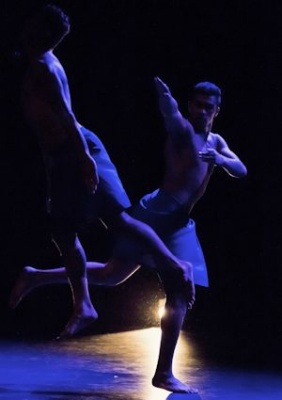The devastating impact of the worldwide pandemic of Spanish Influenza in Samoa in 1918 is the focus of 1918, a poignant new Samoan contemporary dance-theatre work written and directed by Tupe Lualua and choreographed by Andy Faiaoga for Wellington company Le Moana Productions.
As 1918 compellingly communicates, the disease came ashore when infected passengers arrived aboard a ship from New Zealand, and with no quarantine measures in place, spread very quickly as it had done elsewhere in the world. In a period of 2 months it killed 8,500 people of all generations, 22% of the population of Western Samoa.
The key aspects of these historic events are vividly communicated through a heady combination of song and live drumming, video and slide images, occasional audio clips, costumes by Tony de Goldi which cleverly bring the past into the present, and the beautifully crafted, rich interweaving of Siva Samoa and contemporary dance which is clearly tailormade for this production. Considerable research has gone into the selection of gestures and poses, groupings and patterning of the danced material which animates the human interactions, and it is easy to sense the array of photographs from family albums and newspaper archives, library books and film footage which must have been pored through, along with the memories of many people which underlie the narrative.
Nine dancers share with the audience aspects of their daily life in 1918 – at home, at work, in the streets, after church, suggesting an array of people ranging from children to the elderly, teenagers and parents and courting couples. They gather to eat, dance with the drums, socialise circumspectly, and celebrate with much joy and delight. When the supply ship’s horn announces its imminent arrival, they rush to the harbor, eager to buy supplies and catch up with friends who have been offshore. As the disease spreads, they cough, experience difficulties breathing, are subjected to nausea and vomiting, are overcome by weariness and fall down in exhaustion, lose consciousness and then all signs of life.
Such is the speed and numbers hit by the disease that mass graves are the only way to deal with the infection, without any of the normal rites for the dead and comforting rituals for the grieving, increasing the overwhelming sense of loss of life and despair for the future of the country and its cultural traditions.
The facts of the matter, the anger and grief of local people, the sheer insanity of decisions taken in the heat of the moment by the New Zealand administrator of the day, who refused assistance from American Samoa, and proved inadequate to managing the hideous effects of the epidemic, the many reminders from survivors about what must not be forgotten, and the abiding value of fa’a Samoa are given further attention through a formal narrative delivered in Gagana Sāmoa, with considerable gravitas by a tama’ita’i, no doubt enriching the understanding of the work for those who speak the language.
A coda section provides a sense of afterlife, a world with cultural order restored, followed by a lovely postscript delivered by the cast, led by choreographer/performer Andy Faiaoga, and with a luminous performance of Siva Samoa by Tupe Lualua adding to the intensity of rapturous applause from the opening night audience for this Auckland season.
Copyright © in the review belongs to the reviewer





Comments